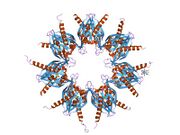Biology:CAMK2A
 Generic protein structure example |
Calcium/calmodulin-dependent protein kinase type II alpha chain (CAMKIIα) is an enzyme that in humans is encoded by the CAMK2A gene.[1][2]
Function
The product of this gene belongs to the Serine/Threonine protein kinases family, and to the Ca2+/calmodulin-dependent protein kinase II subfamily. Calcium signaling is crucial for several aspects of plasticity at glutamatergic synapses. This enzyme is composed of four different chains: alpha, beta, gamma, and delta. The alpha chain encoded by this gene is required for hippocampal long-term potentiation (LTP) and spatial learning(needs citation, perhaps Harvward et al. 2016). In addition to its calcium-calmodulin (CaM)-dependent activity, this protein can undergo autophosphorylation, resulting in CaM-independent activity. Two transcript variants encoding distinct isoforms have been identified for this gene.[3]
Interactions
CAMK2A has been shown to interact with:
References
- ↑ "Prediction of the coding sequences of unidentified human genes. XIII. The complete sequences of 100 new cDNA clones from brain which code for large proteins in vitro". DNA Res 6 (1): 63–70. Jul 1999. doi:10.1093/dnares/6.1.63. PMID 10231032.
- ↑ "Molecular cloning of a brain-specific calcium/calmodulin-dependent protein kinase". Proc Natl Acad Sci U S A 84 (16): 5962–6. Sep 1987. doi:10.1073/pnas.84.16.5962. PMID 3475713.
- ↑ "Entrez Gene: CAMK2A calcium/calmodulin-dependent protein kinase (CaM kinase) II alpha". https://www.ncbi.nlm.nih.gov/sites/entrez?Db=gene&Cmd=ShowDetailView&TermToSearch=815.
- ↑ "Densin-180 forms a ternary complex with the (alpha)-subunit of Ca2+/calmodulin-dependent protein kinase II and (alpha)-actinin". J. Neurosci. 21 (2): 423–33. Jan 2001. PMID 11160423.
- ↑ "The cyclin-dependent kinase 5 activators p35 and p39 interact with the alpha-subunit of Ca2+/calmodulin-dependent protein kinase II and alpha-actinin-1 in a calcium-dependent manner". J. Neurosci. 22 (18): 7879–91. Sep 2002. PMID 12223541.
- ↑ "CaMKII-dependent phosphorylation regulates SAP97/NR2A interaction". J. Biol. Chem. 278 (45): 44745–52. Nov 2003. doi:10.1074/jbc.M303576200. PMID 12933808.
Further reading
- "CaM-kinases: modulators of synaptic plasticity.". Curr. Opin. Neurobiol. 10 (3): 375–80. 2000. doi:10.1016/S0959-4388(00)00090-8. PMID 10851169.
- "Ca(2+)/CaM-dependent kinases: from activation to function.". Annu. Rev. Pharmacol. Toxicol. 41 (1): 471–505. 2001. doi:10.1146/annurev.pharmtox.41.1.471. PMID 11264466.
- "[Molecular mechanisms of the intracellular localizations of Ca2+/calmodulin-dependent protein kinase II isoforms, and their physiological functions]". Tanpakushitsu Kakusan Koso 47 (3): 241–7. 2002. PMID 11889801.
- "Mechanism of desensitization of the epidermal growth factor receptor protein-tyrosine kinase.". J. Biol. Chem. 267 (2): 1129–40. 1992. PMID 1309762.
- "Calcium-regulated phosphorylation within the leucine zipper of C/EBP beta.". Science 256 (5055): 370–3. 1992. doi:10.1126/science.256.5055.370. PMID 1314426.
- "PKC epsilon-related kinase associates with and phosphorylates cytokeratin 8 and 18.". J. Cell Biol. 117 (3): 583–93. 1992. doi:10.1083/jcb.117.3.583. PMID 1374067.
- "Nitric oxide synthase regulatory sites. Phosphorylation by cyclic AMP-dependent protein kinase, protein kinase C, and calcium/calmodulin protein kinase; identification of flavin and calmodulin binding sites.". J. Biol. Chem. 267 (16): 10976–81. 1992. PMID 1375933.
- "Ca2(+)-calmodulin-dependent protein kinase II phosphorylates various types of non-epithelial intermediate filament proteins.". Biochem. Biophys. Res. Commun. 169 (3): 896–904. 1990. doi:10.1016/0006-291X(90)91977-Z. PMID 2114109.
- "Phosphorylation sites linked to glial filament disassembly in vitro locate in a non-alpha-helical head domain.". J. Biol. Chem. 265 (8): 4722–9. 1990. PMID 2155236.
- "Ca2+/calmodulin-dependent protein kinase II: localization in the interphase nucleus and the mitotic apparatus of mammalian cells.". Proc. Natl. Acad. Sci. U.S.A. 87 (14): 5341–5. 1990. doi:10.1073/pnas.87.14.5341. PMID 2164678.
- "Protein kinase A phosphorylates retinal phosducin on serine 73 in situ.". J. Biol. Chem. 265 (26): 15860–6. 1990. PMID 2394752.
- "Identification of the major physiologic phosphorylation site of human keratin 18: potential kinases and a role in filament reorganization.". J. Cell Biol. 127 (1): 161–71. 1994. doi:10.1083/jcb.127.1.161. PMID 7523419.
- "Microtubule-associated protein/microtubule affinity-regulating kinase (p110mark). A novel protein kinase that regulates tau-microtubule interactions and dynamic instability by phosphorylation at the Alzheimer-specific site serine 262.". J. Biol. Chem. 270 (13): 7679–88. 1995. doi:10.1074/jbc.270.13.7679. PMID 7706316.
- "Identification of phosphorylation sites on glial fibrillary acidic protein for cdc2 kinase and Ca(2+)-calmodulin-dependent protein kinase II.". J. Biochem. 116 (2): 426–34. 1995. PMID 7822264.
- "Identification of Ser38 as the site in cardiac sarcoplasmic reticulum Ca(2+)-ATPase that is phosphorylated by Ca2+/calmodulin-dependent protein kinase.". J. Biol. Chem. 269 (42): 26492–6. 1994. PMID 7929371.
- "A growth factor-induced kinase phosphorylates the serum response factor at a site that regulates its DNA-binding activity.". Mol. Cell. Biol. 13 (10): 6260–73. 1993. doi:10.1128/mcb.13.10.6260. PMID 8413226.
- "Identification of a phosphorylation site for calcium/calmodulindependent protein kinase II in the NR2B subunit of the N-methyl-D-aspartate receptor.". J. Biol. Chem. 271 (49): 31670–8. 1997. doi:10.1074/jbc.271.49.31670. PMID 8940188.
- "Mice expressing activated CaMKII lack low frequency LTP and do not form stable place cells in the CA1 region of the hippocampus.". Cell 87 (7): 1351–61. 1997. doi:10.1016/S0092-8674(00)81829-2. PMID 8980240.
- "The regulatory Ser262 of microtubule-associated protein tau is phosphorylated by phosphorylase kinase.". J. Biol. Chem. 272 (3): 1777–85. 1997. doi:10.1074/jbc.272.3.1777. PMID 8999860.
External links
- Human CAMK2A genome location and CAMK2A gene details page in the UCSC Genome Browser.


